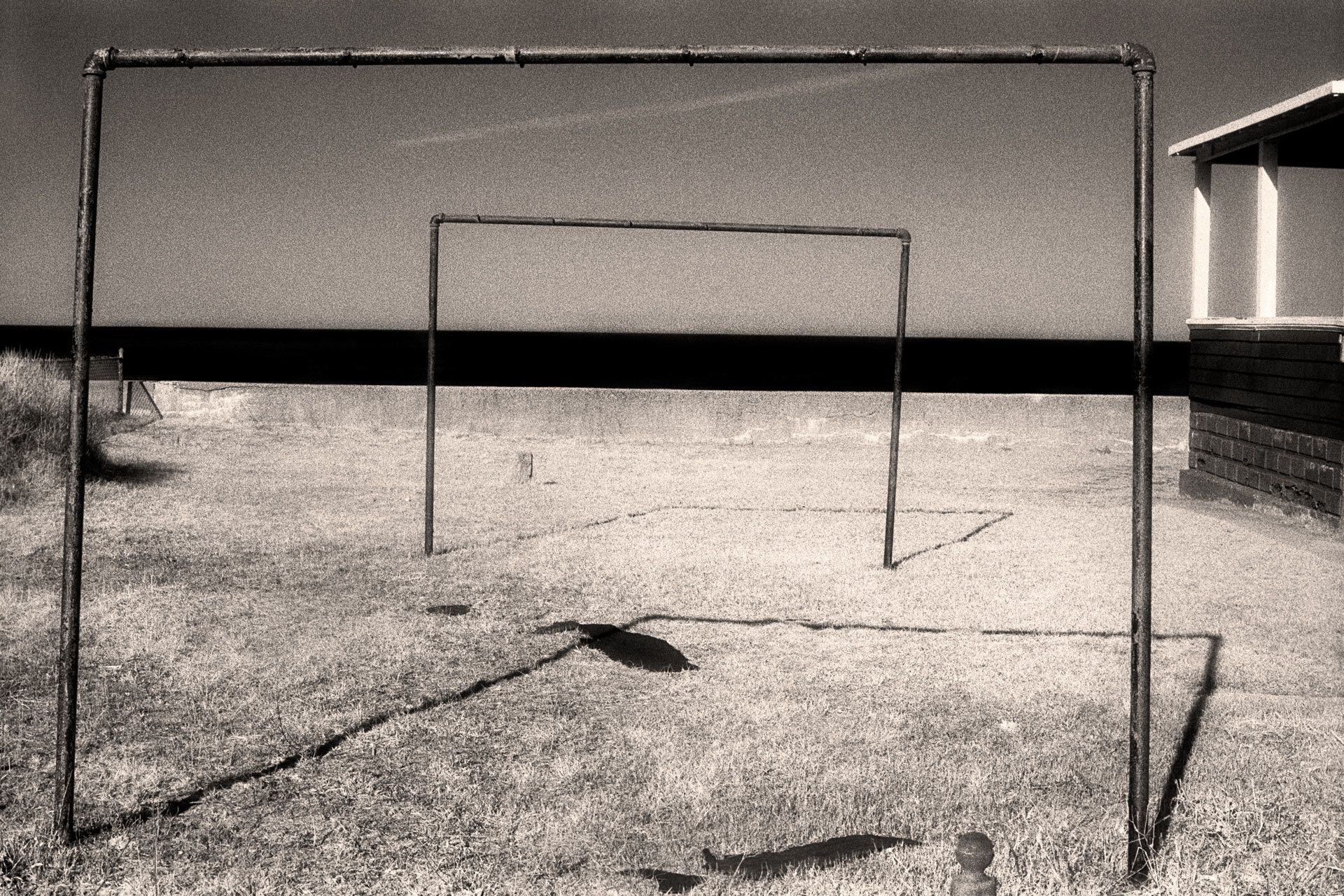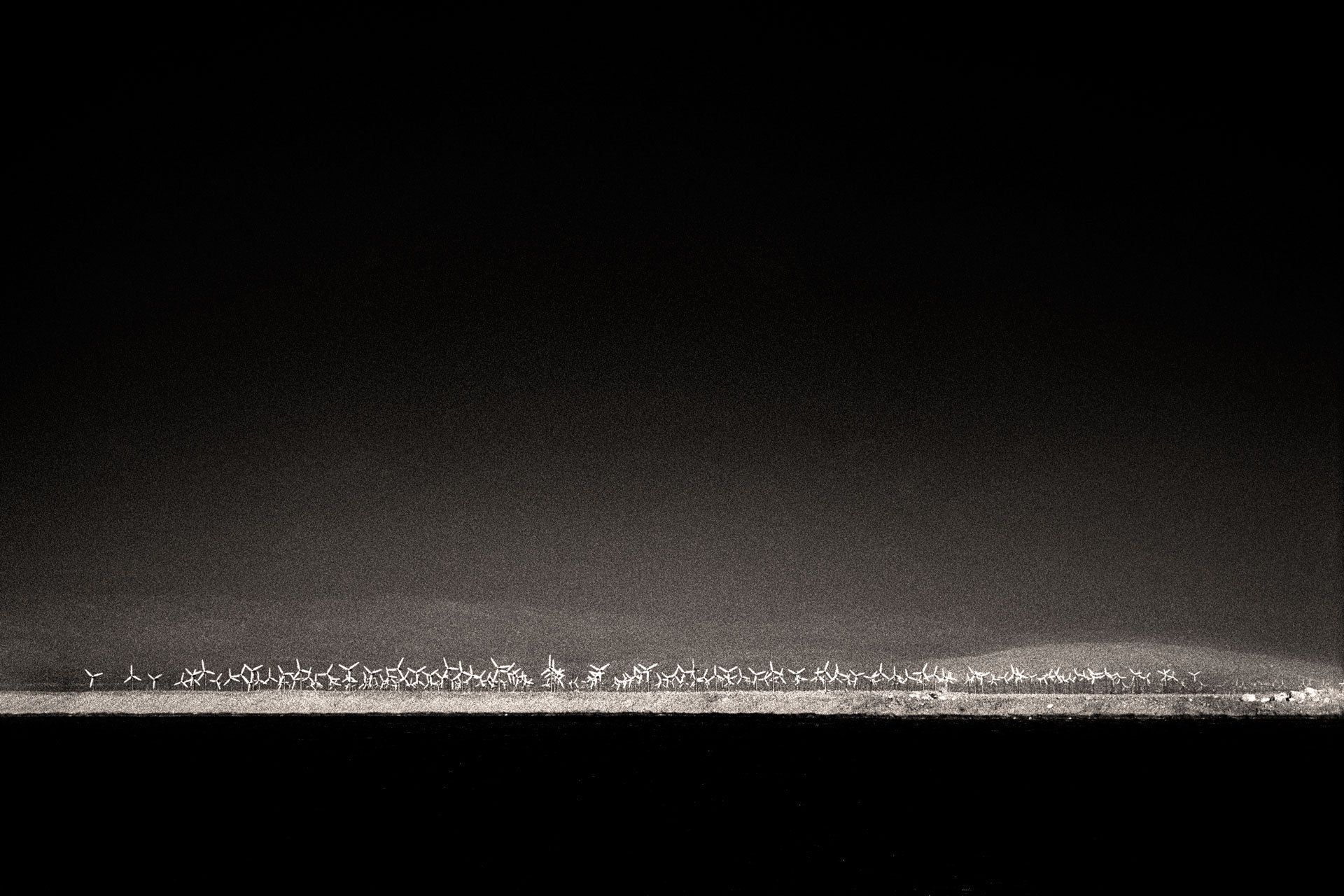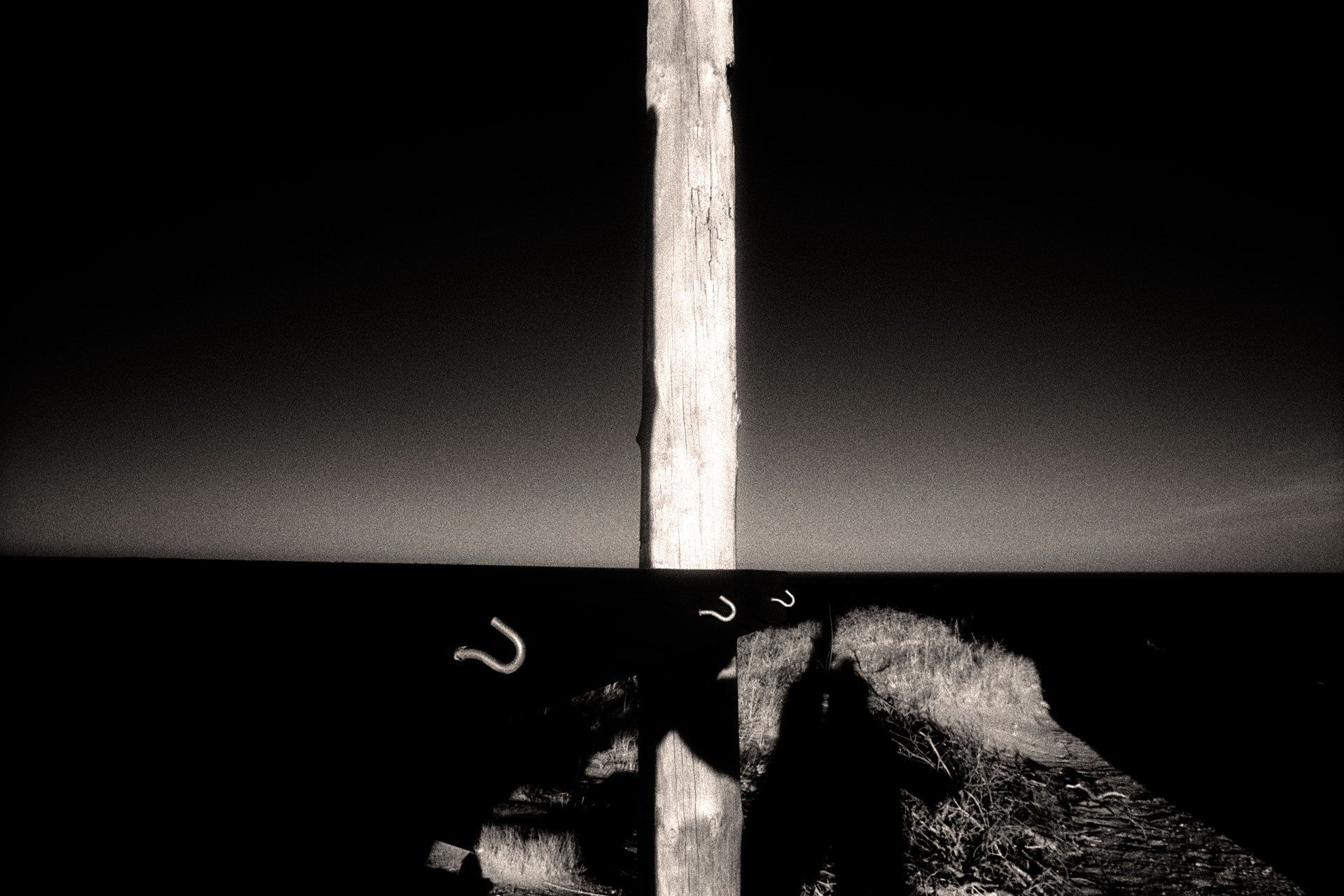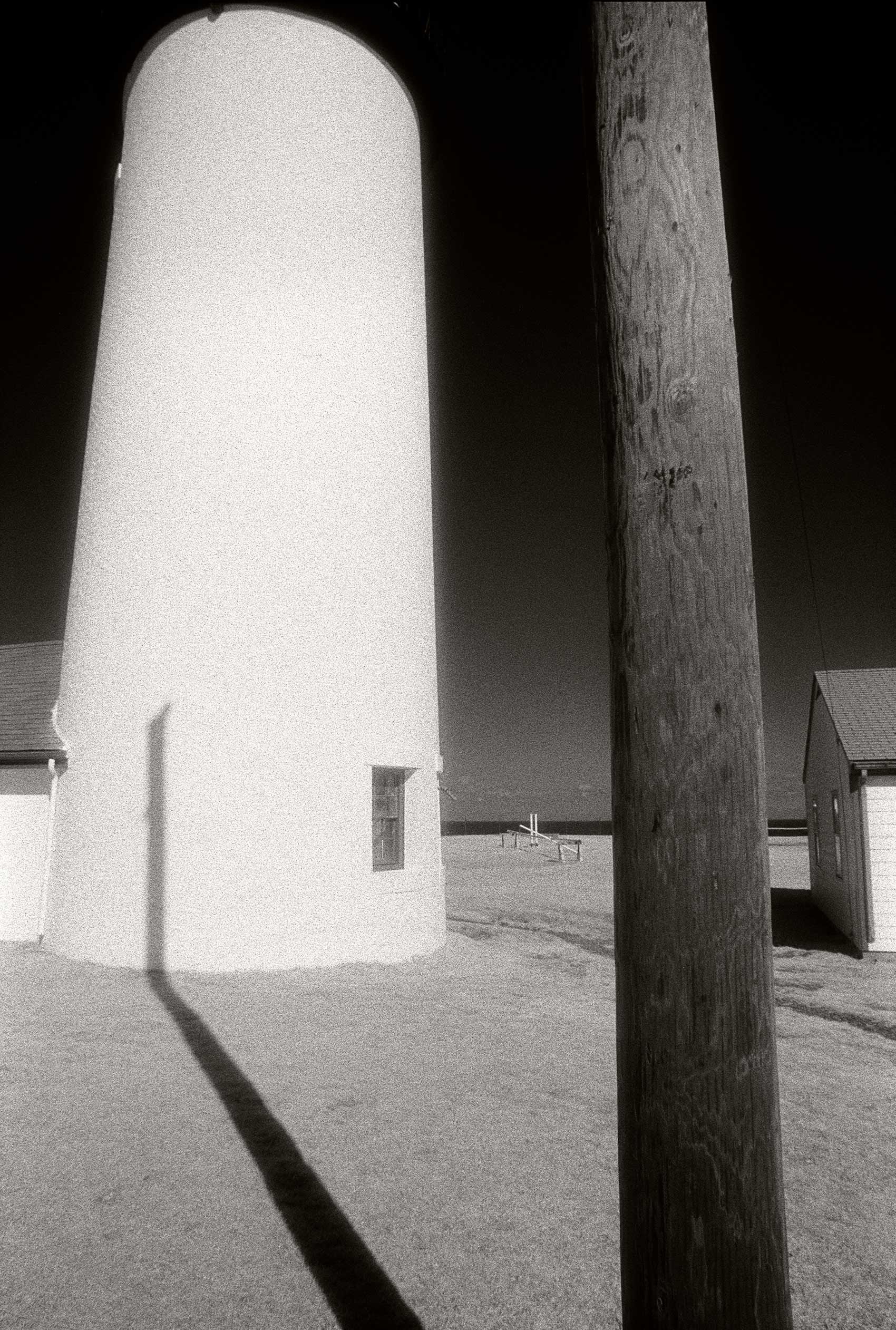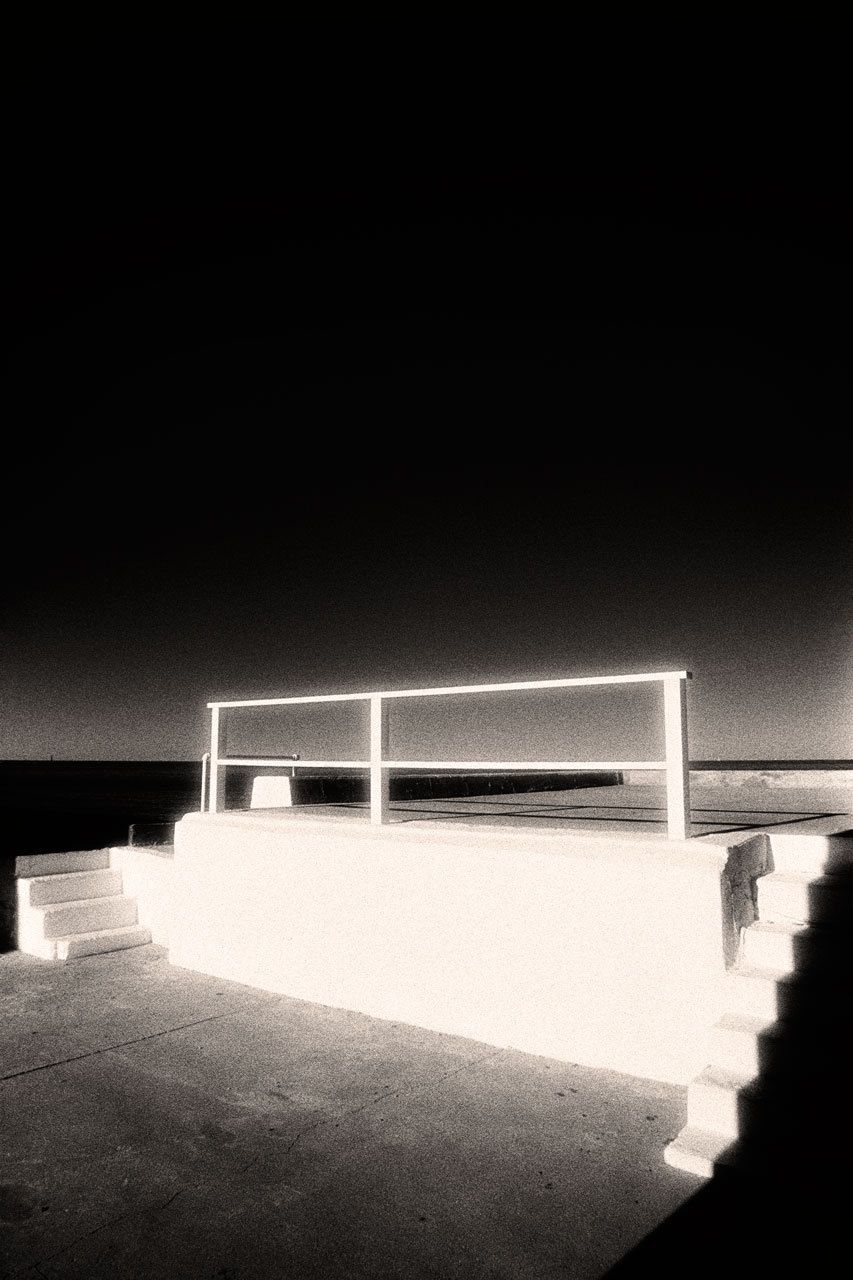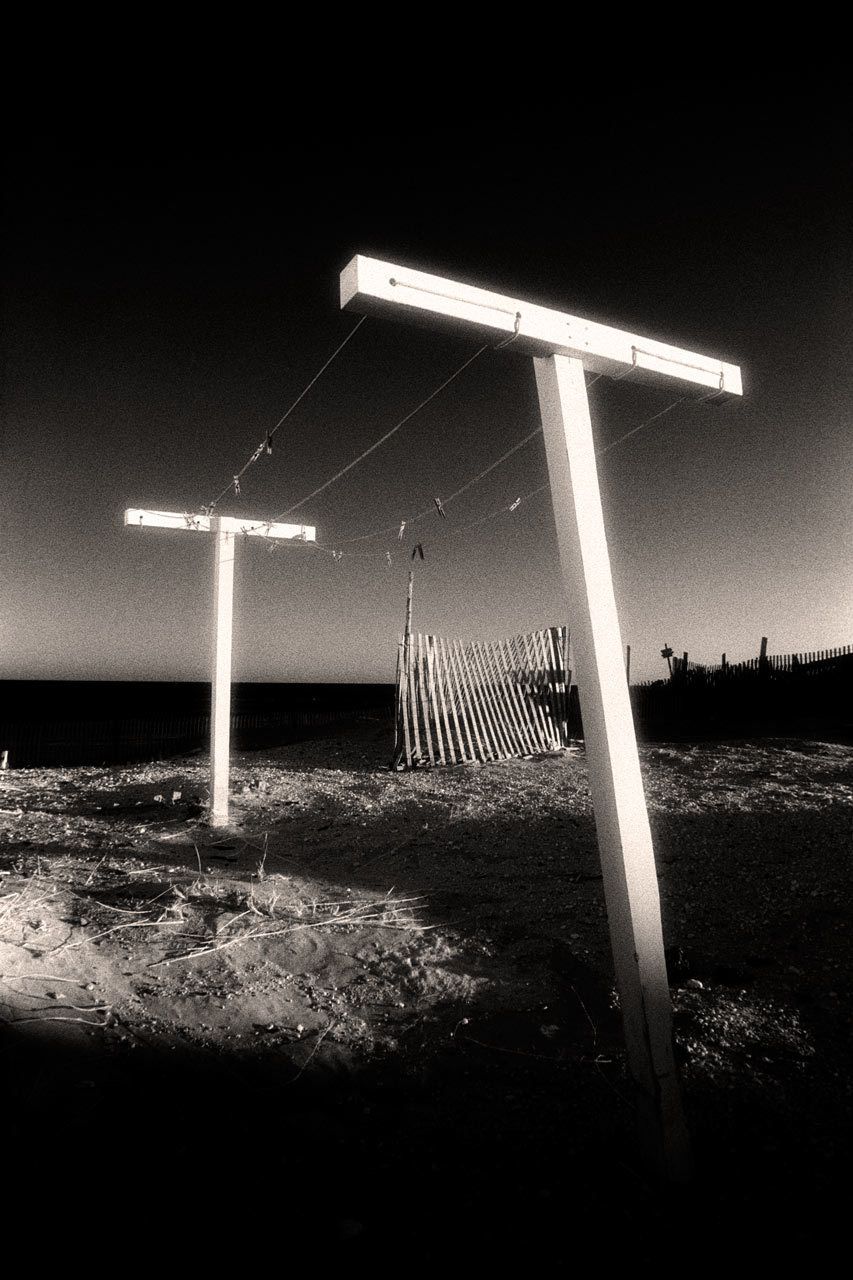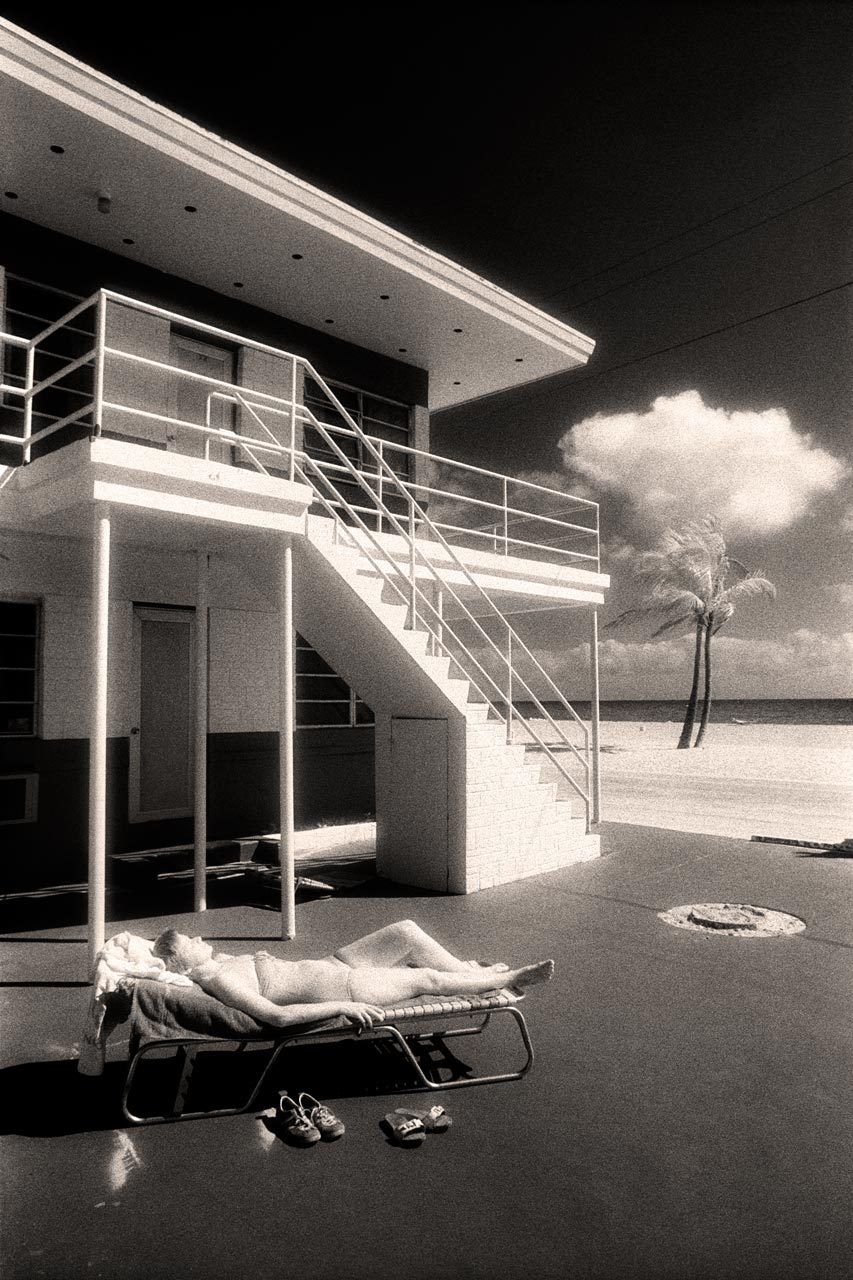-
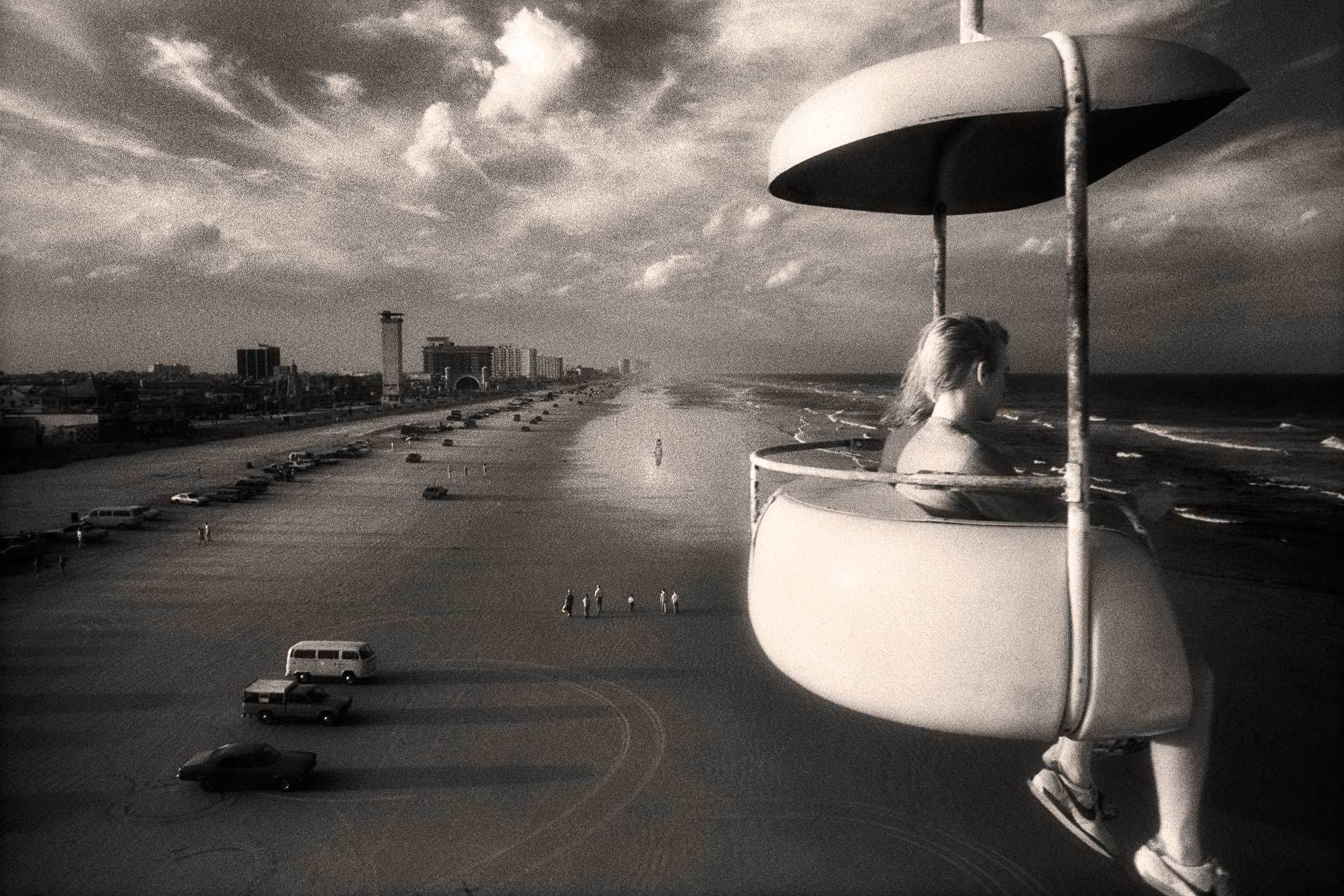
Amusement Park, Daytona Beach
This photograph was taken just as the sun was setting, from a passing gondola, on a ride at an amusement park atop a pier in Daytona Beach, Florida. Below, you can see the beach with walking figures and cars, which are allowed to drive and park on the sand. The image's sense of depth comes from strong linear perspective, produced by horizontal lines that recede to a "vanishing point."
-
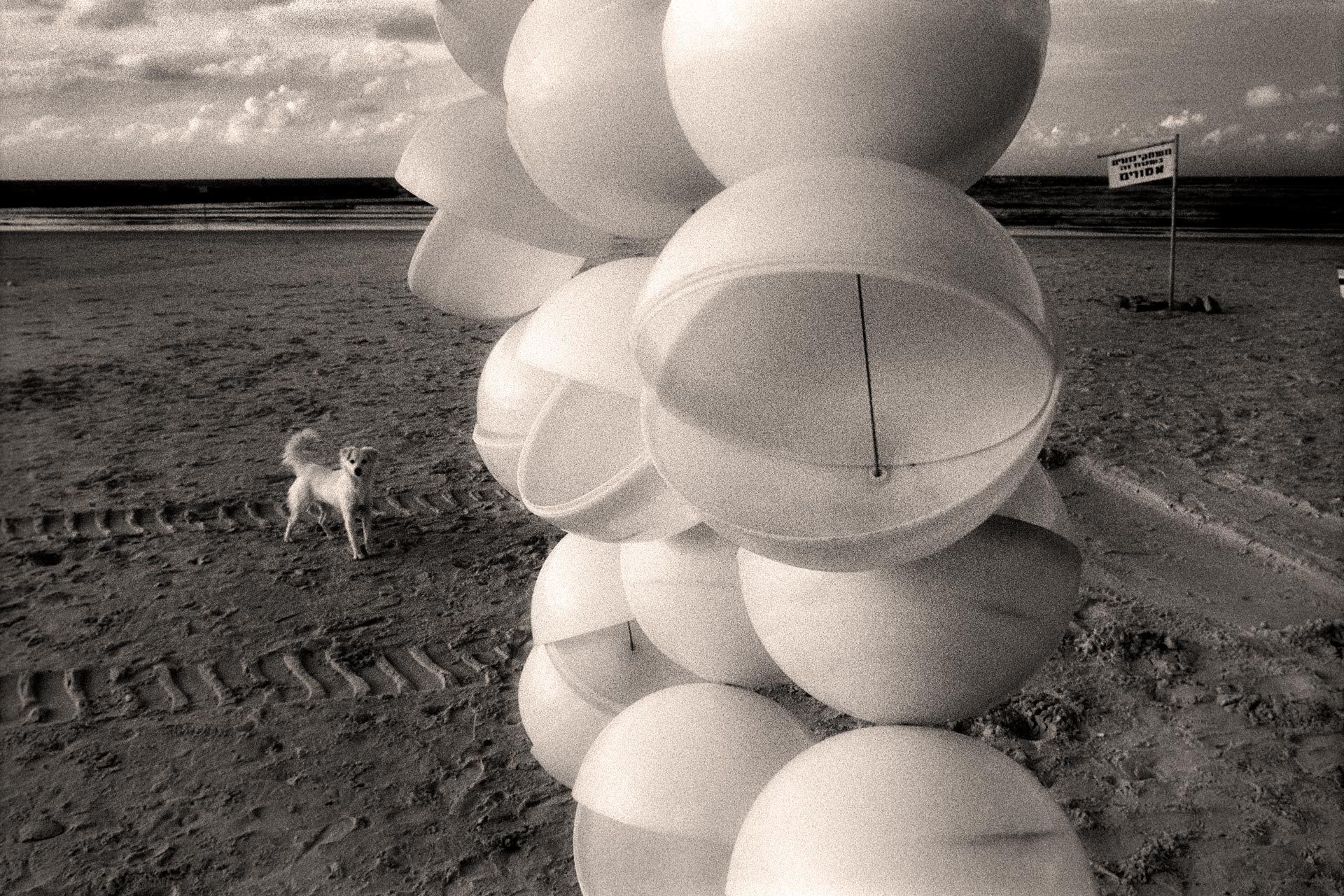
Dog on the Beach, Netanya
This photograph was taken on the beach in Netanya, Israel after a Mediterranean storm knocked down concrete decorative structures that had been erected just days before. Stylized to look like oversized beach umbrellas, the massive structures featured strings of large, multicolored plastic balls suspended on wires, and when they fell the balls split apart and were left dangling on the wires. I was photographing the destruction when a small dog started to follow me around, and soon became a motif of the pictures.
-
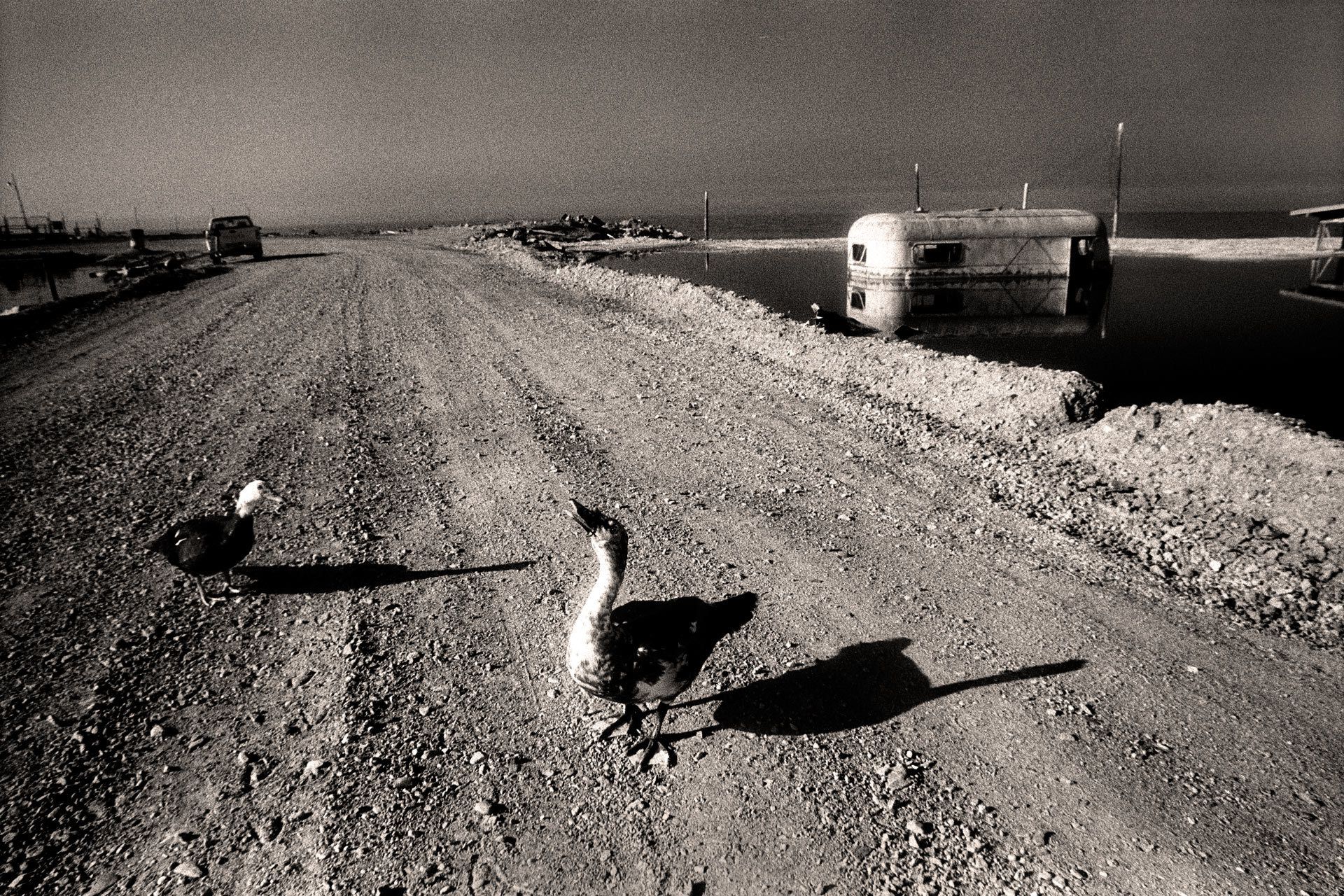
Angry Goose at the Salton Sea
This photograph was made at the Salton Sea, a recreational area built around a lake created when overflow from the Colorado River filled a huge salt pan. It's in the dusty Imperial Valley of Southern California, not far from Palm Springs. The Salton Sea's unpredictable levels and high salinity, which led to massive fish kills, has made it virtually uninhabitable, though some still live around it. Parts of its shore have flooded, causing the abandonment of homes and trailers.
-
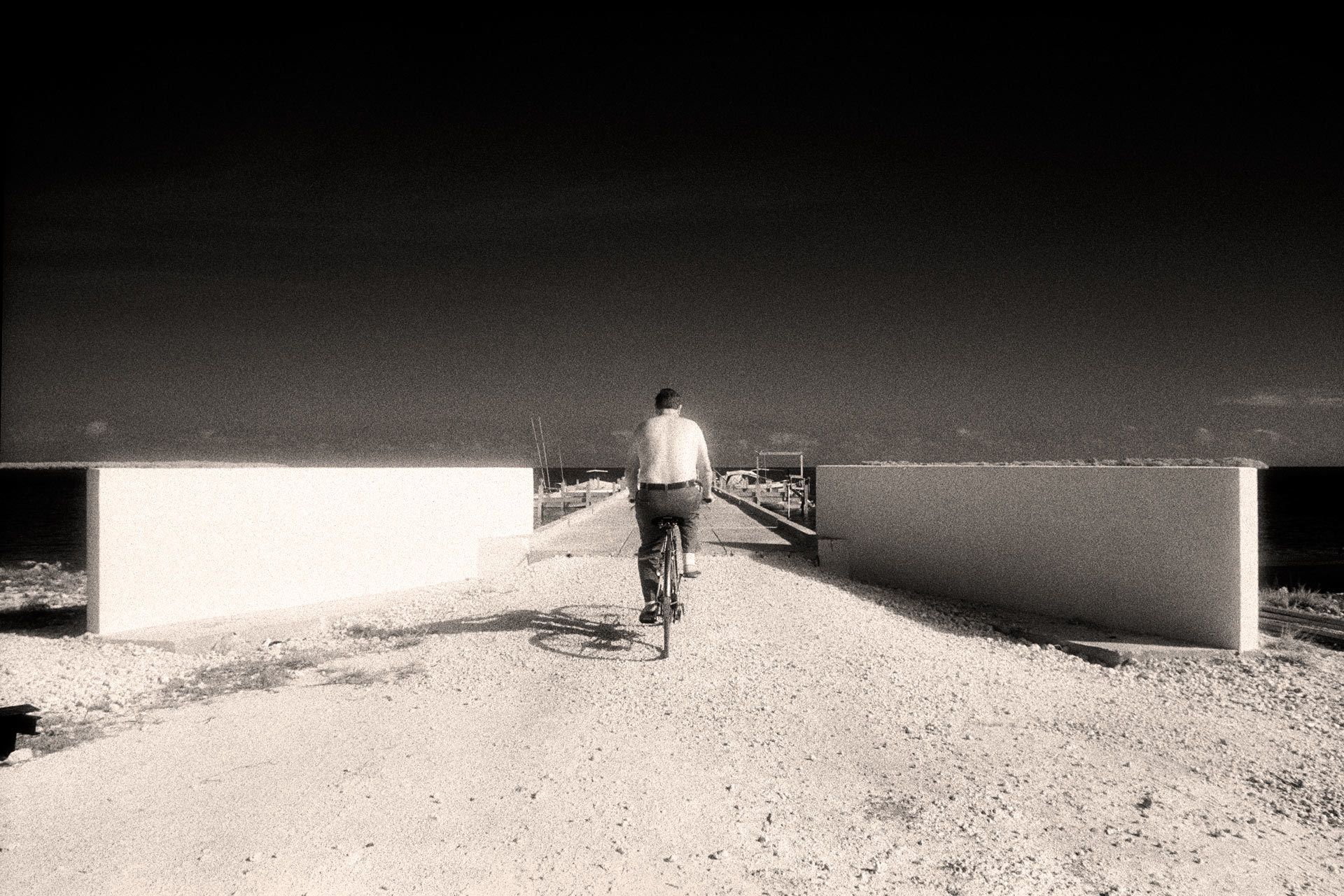
Biking Down the Pier, Florida Keys
A man on a bicycle rides down a pier in the Florida Keys, heading straight into the Gulf of Mexico. The freestanding concrete walls that served as a gateway to the pier, painted white like so many things in South Florida, were what first caught my eye. When I noticed a nearby bicyclist I waited to take the picture until he rode directly through them.
-
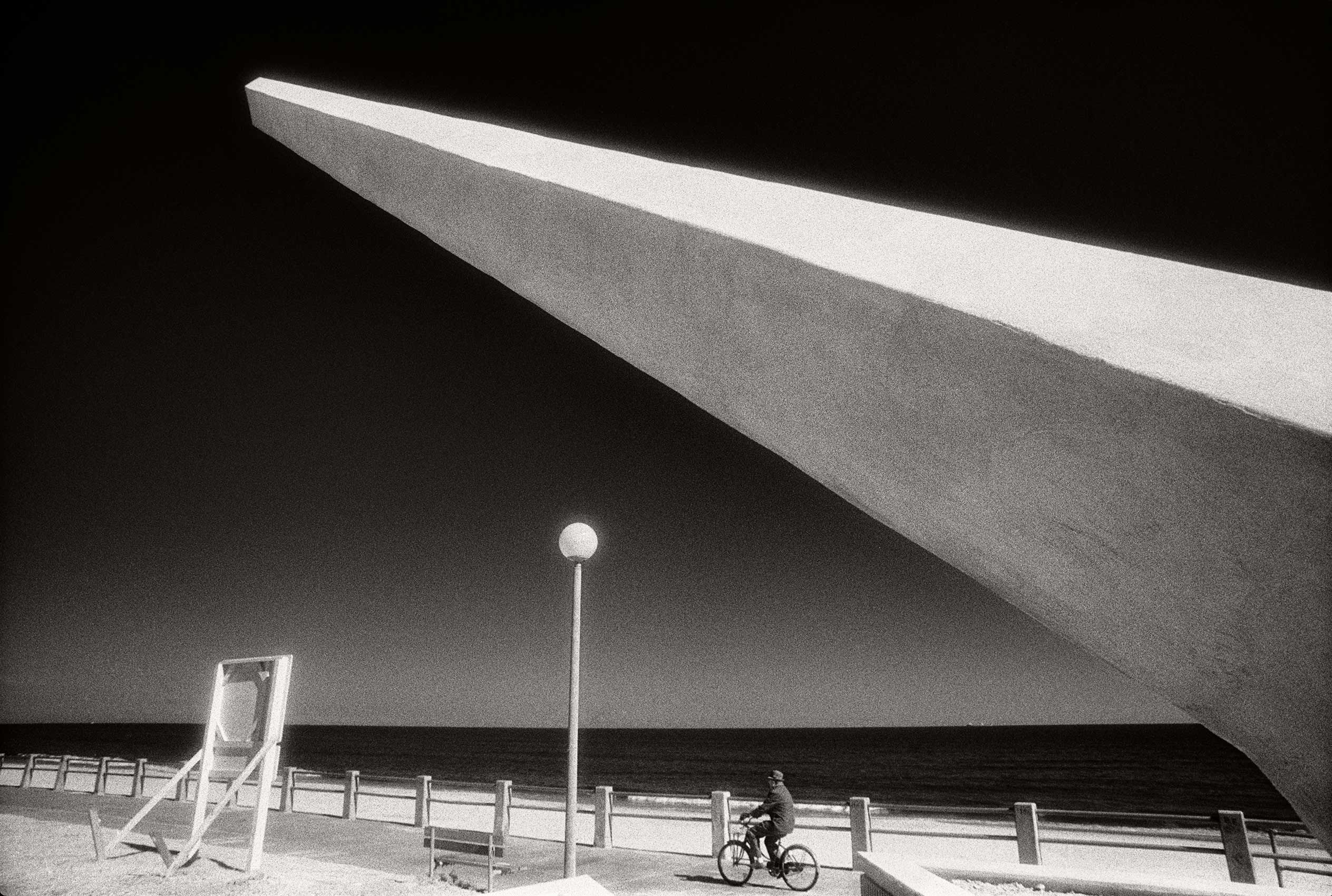
Sundial, Virginia Beach
A cast-cement sundial looms over a bicyclist along the Virginia Beach boardwalk
-
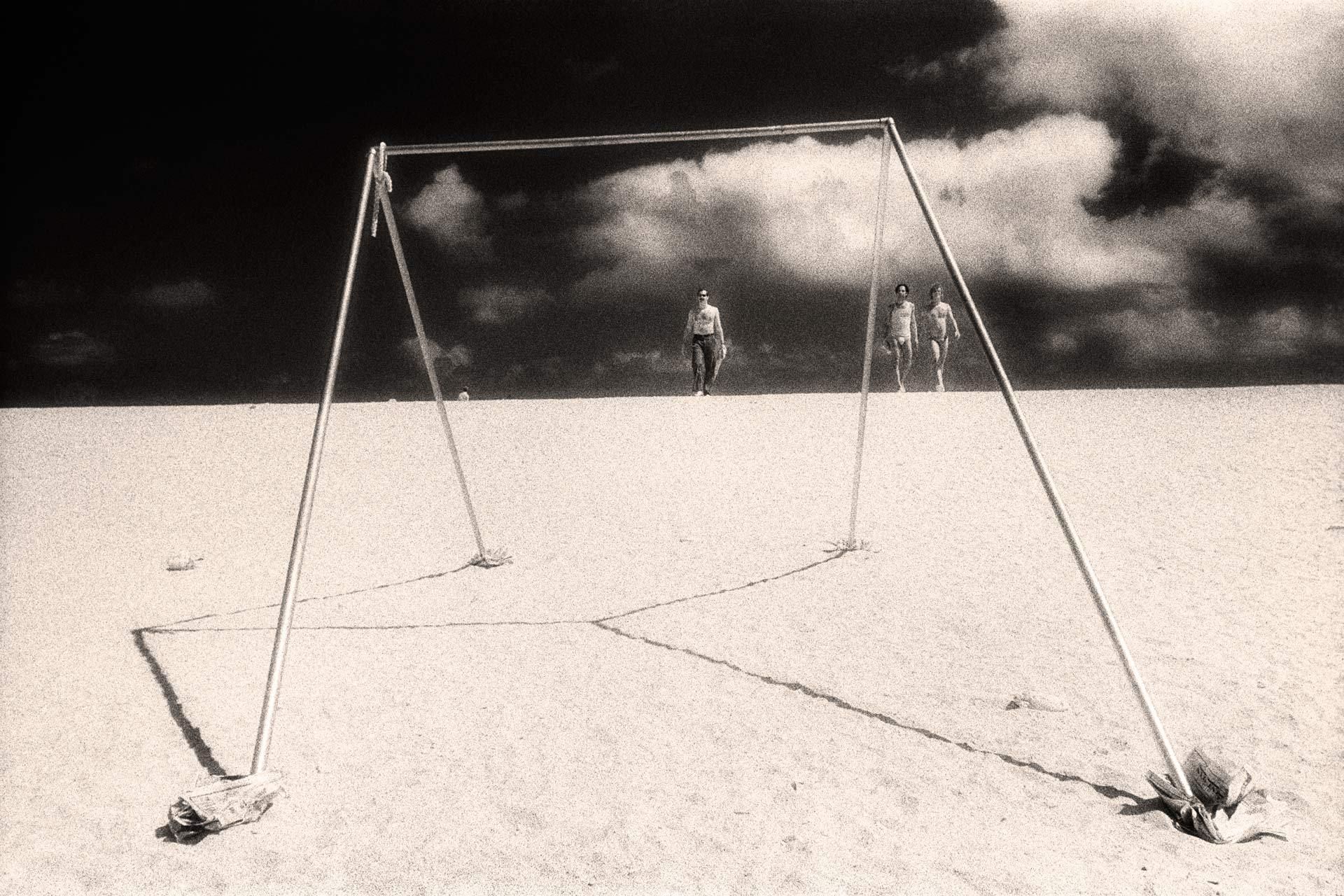
Swingset, Miami Beach
A swingset-like structure sits on the sand of Miami Beach, kept from sinking in by folded newspapers, one of them in Yiddish. The structure itself was what first interested me, but the scene was too simple, so I waited for people walking on the beach to appear along the tidal crest beyond it. I shot many frames so I would get one in which the figures were somehow integrated with the structure.
-
![The inverted U-shaped structures in this photograph, which was taken in Marshfield, Massachusetts, are used for stringing clothesline. I originally shot this photograph as a stereo view, printing it as a card that could be seen in 3D using a 19th-century stereoopticon viewer, a fixture of Victorian parlors. In order to produce the 3D effect, I exposed two frames of the subject three inches apart--about the distance between human pupils. When "fused" into a single image by the prisms in a stereo viewer, this produces a powerful illusion of depth. The black band is the ocean, darkened with a red filter. Clothesline, Marshfield]()
Clothesline, Marshfield
The inverted U-shaped structures in this photograph, which was taken in Marshfield, Massachusetts, are used for stringing clothesline. I originally shot this photograph as a stereo view, printing it as a card that could be seen in 3D using a 19th-century stereoopticon viewer, a fixture of Victorian parlors. In order to produce the 3D effect, I exposed two frames of the subject three inches apart--about the distance between human pupils. When "fused" into a single image by the prisms in a stereo viewer, this produces a powerful illusion of depth. The black band is the ocean, darkened with a red filter.
-
![A "farm" of power-generating wind turbines, modern-day windmills, fills the far side of a manmade lake in Southern California. My thought in photographing the structures this way was to make them seem tiny in scale, when in reality they're massive. I also wanted to create a highly simplified composition, something akin to "field" painting. To help with this I used a red filter, which darkened the blue sky and turned the lake almost black. The sky looks less dark at the bottom because it isn't as blue there--creating the illusion of light over the horizon. Farming Wind]()
Farming Wind
A "farm" of power-generating wind turbines, modern-day windmills, fills the far side of a manmade lake in Southern California. My thought in photographing the structures this way was to make them seem tiny in scale, when in reality they're massive. I also wanted to create a highly simplified composition, something akin to "field" painting. To help with this I used a red filter, which darkened the blue sky and turned the lake almost black. The sky looks less dark at the bottom because it isn't as blue there--creating the illusion of light over the horizon.
-
![Created on a frigid winter day somewhere on Cape Cod, this photograph of a clothesline structure was one of my first infrared images in which the result was exactly how I had previsualized it--with the hooks suspended in space and receding into the distance. I also knew that because the wooden board to which the hooks were attached was in shadow, it would merge in tone with the distant blue ocean, which was itself darkened with a red filter. I lined up the board and ocean to form a single horizon, anticipating that the graduated sky would produce the feeling of a rising or setting sun. Hooks to Nowhere]()
Hooks to Nowhere
Created on a frigid winter day somewhere on Cape Cod, this photograph of a clothesline structure was one of my first infrared images in which the result was exactly how I had previsualized it--with the hooks suspended in space and receding into the distance. I also knew that because the wooden board to which the hooks were attached was in shadow, it would merge in tone with the distant blue ocean, which was itself darkened with a red filter. I lined up the board and ocean to form a single horizon, anticipating that the graduated sky would produce the feeling of a rising or setting sun.
-
![An unwanted clawfoot bathtub lies on its side in Scituate, on Boston's South Shore Defunct Bathtub, Scituate]()
Defunct Bathtub, Scituate
An unwanted clawfoot bathtub lies on its side in Scituate, on Boston's South Shore
-
![A lighthouse and long shadows on Cape Cod Homage to de Chirico]()
Homage to de Chirico
A lighthouse and long shadows on Cape Cod
-
![Photographed on Boston's South Shore, this concrete deck was built by the owners of the house across the street in order to enjoy their view of Massachusetts Bay. It was painted white, and the winter sun gave it a brilliance reminding me of Emerson's comment that "there is no object so foul that intense light will not make beautiful." Kodak infrared film's lack of the antihalation backing found in normal film caused the bright light to spread out when it struck the emulsion, creating a glowing effect. I aligned the middle horizontal element of the railing with the ocean horizon, a narrow black band at right. Glowing Rail, South Shore]()
Glowing Rail, South Shore
Photographed on Boston's South Shore, this concrete deck was built by the owners of the house across the street in order to enjoy their view of Massachusetts Bay. It was painted white, and the winter sun gave it a brilliance reminding me of Emerson's comment that "there is no object so foul that intense light will not make beautiful." Kodak infrared film's lack of the antihalation backing found in normal film caused the bright light to spread out when it struck the emulsion, creating a glowing effect. I aligned the middle horizontal element of the railing with the ocean horizon, a narrow black band at right.
-
![A clothesline near the beach on Cape Cod, Massachusetts, photographed by very low winter sun. The light in this image reminds me of a movie set, an effect enhanced by the way the horizon's glow (caused by my red filter's graduated darkening of the blue sky) silhouettes erosion-control fencing at the center right of the image. The black band behind the far support is the sea itself, also darkened by the filter with help in printing. Cape Cod Clothesline]()
Cape Cod Clothesline
A clothesline near the beach on Cape Cod, Massachusetts, photographed by very low winter sun. The light in this image reminds me of a movie set, an effect enhanced by the way the horizon's glow (caused by my red filter's graduated darkening of the blue sky) silhouettes erosion-control fencing at the center right of the image. The black band behind the far support is the sea itself, also darkened by the filter with help in printing.
-
![A sunbather soaks up rays by the boardwalk in Hollywood, Florida. Just north of the more famous beach in Miami, Hollywood is a polyglot enclave of European and French-Canadian tourists that's full of small, Art Deco-style motels and pensiones. This photograph's characteristic glow, as with the other infrared images, comes from the film's lack of an antihalation backing, an absence that allows light striking the emulsion's surface to spread out. Sunbathing in Hollywood]()
Sunbathing in Hollywood
A sunbather soaks up rays by the boardwalk in Hollywood, Florida. Just north of the more famous beach in Miami, Hollywood is a polyglot enclave of European and French-Canadian tourists that's full of small, Art Deco-style motels and pensiones. This photograph's characteristic glow, as with the other infrared images, comes from the film's lack of an antihalation backing, an absence that allows light striking the emulsion's surface to spread out.

